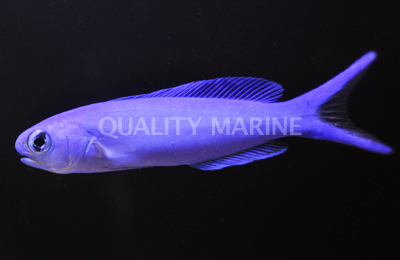Hoplolatilus Tilefish

Tilefish are brilliantly colored with an active temperament and the inclination to play in the substrate. Most aquarium species are burrowers, digging a home out from under rocks to use as cover from predators and a safe haven for sleeping. Tilefish are often incorrectly categorized as gobies, which is not surprising considering their diminutive size and elongate, cigar-shaped bodies. However, they are not closely related to gobies (the family Gobiidae) instead belonging to the family Malacanthidae, which also includes some larger species of commercial interest. The more common aquarium species are long and narrow, with small mouths and deeply forked tails. Both dorsal and anal fin structures are similarly long. These fish will usually not exceed 8 inches in total length, which needs to be taken into account when choosing an aquarium size.
Hoplolatilus tilefish are the most common aquarium
inhabitants due to their smaller size, and often colorful markings. A few are even capable of rapidly shifting their colors and markings. This flashing behavior is fantastically beautiful and while actually producing light, it still creates a brilliant shimmer and occurs in the blink of an eye. Varieties available for trade include the Blue Jaw Tilefish (H. starcki), Chameleon Yellow Tilefish (H. luteus), Dusky Tilefish (H. cuniculus), Flashing Tilefish (H. chlupatyi), Purple Tilefish (H. purpureus) and the Pastel Tilefish (H. fronticinctus). When collected using detrimental processes, many aquarists experience high mortality levels. However, at Quality Marine we obtain tilefish from reputable suppliers that insist upon ecologically safe collection practices.
Hoplolatilus tilefish are found throughout the Indo-Pacific, ranging from the Red Sea in the west all the way out the central pacific in the east. In fact, they are quite common and widespread throughout that region of the world, yet they not commonly experienced in the trade. Most species of interest in the aquarium trade hail from Southeast Asia. Generally considered coral reef species, tilefish are most often found on sandy or silty substrates right at the base of the reef structure. This means that they are often found in deeper waters, sometimes over 100 feet. Tilefish tend to hover above their lair while they hunt for food. When they sense danger, they quickly retreat to their burrows until the threat has passed. Tilefish are diurnal, meaning they are active during the day.
Often considered a difficult variety of fish to keep in captivity, tilefish require a high level of husbandry. As they are fairly active, they require both free swimming

Hoplolatilus starcki juv MAC
space and good cover. Water quality conditions should be maintained within typical marine aquarium ranges, while stability of these parameters is of the utmost importance. Water temperature must also match tropical conditions, ranging from 72oF to 78oF. Due to their deeper water origins in the wild, we recommend keeping these fish under low to moderate lighting conditions. Tilefish do best with a sandy substrate, at least 3 inches deep, allowing them to dig sufficient burrows. Providing live rock or other solid structures is ideal, as it mimics the cover these fish would seek out in the wild. Be sure the structures are secure to prevent collapsing as burrows are created. Though they are relatively peaceful and reef-safe, some species like the Purple tilefish are territorial towards conspecifics (individuals of the same species). Due to their small size and relatively high activity level, they do best when fed small amounts multiple times daily. Their natural diet of plankton lends itself to the types of food commonly available to aquarists, such as mysid shrimp or other frozen meaty foods. Though they do require some detailed care, Hoplolatilus tilefish make for a stunning display in the home aquarium. With a stable aquarium system and good attention to feeding requirements, Fish that are sourced well can live long, healthy lives in display aquaria.